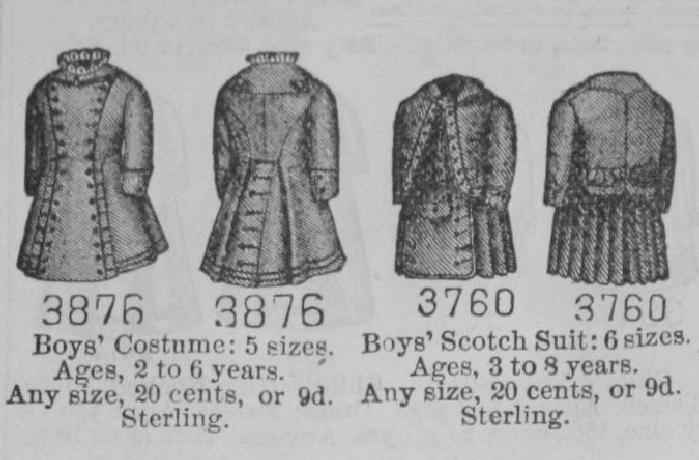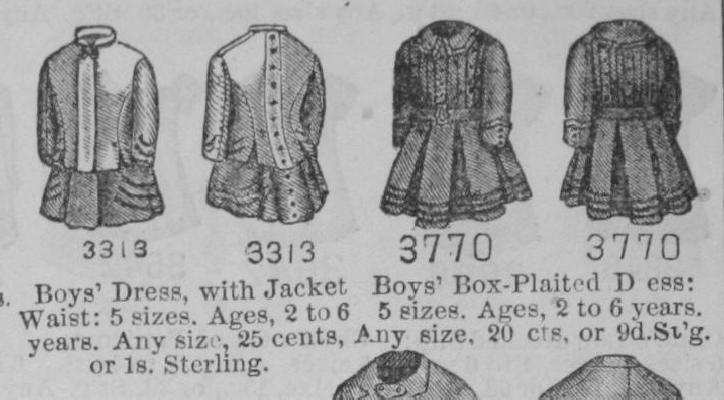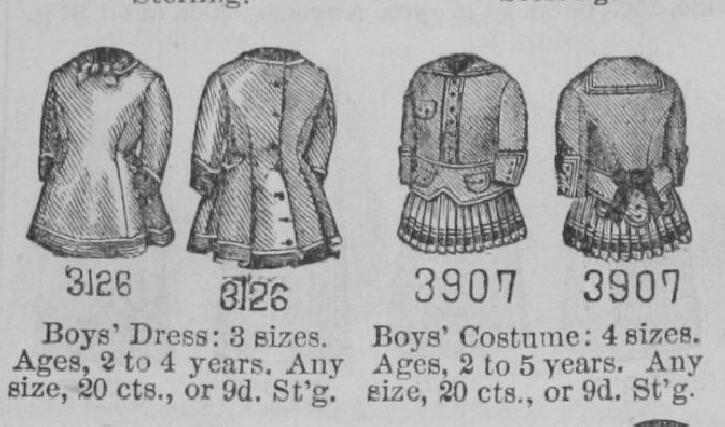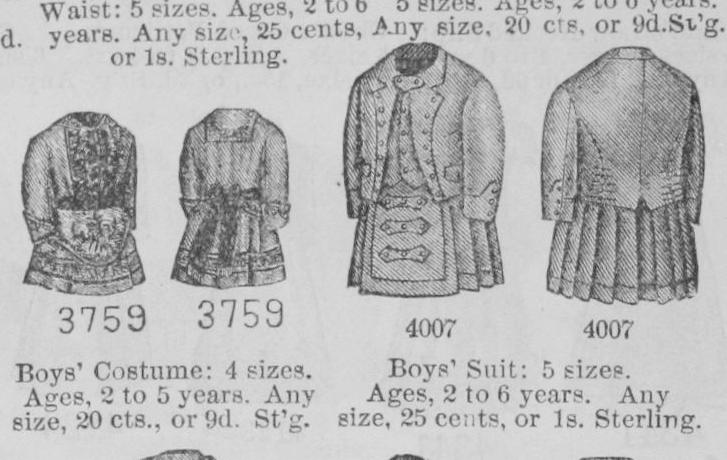
Butterick Dress Patterns (England/United States, 1876)

Figure 1.-- Here are two Butterick patterns. The first (3786) is a dress which Butterock calls a costume. The second (3760) is a kilt suit which Butterick calls a Scotch suit, avoiding the term kilt. The dress is done to size 6 years while the kilt suit is done up to size 8 years. The catalog provided both front and back view.
|
|
Younger boys still very commonly wore dresses in the 1870s. We note a variety of dress outfits for boys in 1876. A dress here was a one piece outfit. Butterick dresses included patterns labeled both costumes and dresses. I am not sure if there was an actual difference. The French word for suit is "costume" this may in part have indluebced the choice of words or perhaps it just sounded better to the boys and parents. We are not sure. All the dresses had a rather plain, suit like look rather than the flouncy styles that girls might wear. The dresses were made to size 4-6 years. This was the age boys commonly began school.
Butterick was founded by Ebeneezer Butterick, a taylor in Stirling, Massachusetts during the Civil War in 1863. He revolutionized the home sewing when he created graded sewing pattern. The inspiration was his wife Ellen who complained that it would be eassier to sew with a pattern. . We do not yet have any of the earliest patterns. We do have a 1900 pattern for a 1900 fancy Fauntleroy blouse. The company continues to be a major force in home and still offers patterns for home sewing. The company in itspromotional literature says that it continues to lead the way in make-it-yourself fashions. I'm not sure just when Butterick began marketing patterns.
New York and London Sales
Butterick marketed these bibs in both New York and London. The fashions I believe are American, but at the time American fashions were very strongly influenced by English fashion. I think the reason that Butterick was selling the patterns in England is not that the fashions were particularly appealing, but that England at the time did not have such useful patterns ad sewing instructions.
Butterick Dresses
Younger boys still very commonly wore dresses in the 1870s. We note a variety of dress outfits for boys in 1876. Butterrick also offered a variety of skirted outfits labeled "suits". These suits had a jacket separate from the dress. A dress was a one piece outfit. This of course was complicated by the fact that some dresses had javkets or nodices that looked liked jackets. Butterick dresses included patterns labeled both costumes and dresses. I am not sure if there was an actual difference. Butterick may be simply using different terms at random or there may be real differences. If so the specific criterion for the two terms eludes us here. The French word for suit is "costume" this may in part have indluebced the choice of words or perhaps it just sounded better to the boys and parents. We are not sure. All the dresses had a rather plain, suit like look rather than the flouncy styles that girls might wear. The dresses were made to size 4-6 years. This was the age boys commonly began school.

Figure 2.-- Here we have two more dresses styles for which Butterick offered ptterns. One (3313) was done with a jacket, giving it the look of a kilt skirt, but note the skirt was not pleated. The other (3770) looks to be a belted dress with box pleats, this was what was meant by "plaited". Both dresses were done in sizes 2 t0 6 years.
|
|
3876: Boys' costume
This dress was done with a small ruffled collar (figure 1). It was a very plain dress with a prominant front panel bordered with what look like buttons. This was a very extensive use of buttons for decorartive purposes. We are not sure why Butterick referred to it as a 'costume' rather than a dress. It was done in sizes 2 to 6 years.
3313: Boys' dress with jacket waist
This was rather a olain dress. The dress was done with a jacket waist that was drawn in at the waist. The jacket rther gave it the look of a kilt skirt (figure 2). Note the skirt has loose folds, but was not pleated. The jacket waist had a very plain collar. I am not entirely sure what was meant by a "jacket waist" as opposed to a basic jacket. There were no visible buttons on the front, but perhaps they were covered by a fly. There seem to be purely decorative buttons on the back. Those buttons continue on the skirt. The sleeves of the jacket had dark decorative arcs which were repeated on the skirt. It was done in sizes 2 t0 6 years.
3770: Boys' box-plaited dress
This was a belted dress with box pleats, this was what was meant by "plaited" (figure 2). Thus seems to have been amn alternative spelling. A box pleat was a fold made in the skirt by doubling the fabric back upon itself and then made more prominant by pressing or stitching the pleat into shape. It was in essence a particularly large pleat. There looks to be a large collar with decorative edgeing. There are vertical lines on the bodice of the dress, I'm not sure just what they represent. The sleeves of this dress had dark bands which were repeated on the hem of the dress. The dress was done in sizes 2 t0 6 years.

Figure 3.-- Here we have two more dresses styles for which Butterick offered ptterns. One (3126) was a very plain back-buttoning dress. The other (3907) looks almost like a kilt suit, but notice the top is not a true jacket. It does not look to be a jacket that can be takeb off separate from the pleated skirt. There was a slight difference in the age range.
|
|
3126: Boys' dress
This was an extremely plain dress, almost stark (figure 3). It had almost no decorative trim. There was a collar, but it is a bit difficult to make out. The coolar seems to have some decoration at the front. It was a back buttoning dress. There seems to a light colored band at the collar which is repeated with a dark band at the bottom hem. This decoration is also found at the sleeve cuffs. It was done in sized 2-4 years. It is not really clear why this dress was done in smaller sizes than some of the other skirted garments on the page.
3907: Boys' costume
This is a somewhat difficult outfit to classify (figure 3). Butternick calls it a "costume" rather than a dress. We are not entirely sure why and what Butterick meant by costume. Note that they do not use the term "suit" as they do for the actual kilt suits. This dress looks almost like a kilt suit, but notice the top is not a true jacket. It does not look to be a jacket that can be take off separate from the pleated skirt. The jacket has sailor styling with a back flap. There are also decorative cuff trim. The jacket buttons may be ornamental. Notive that they do not go all the way down the length od the top,. There is a waist panel at the botoom of the jacket that continues around the back where the two ends fall diagonally and cross. Here a bow seems to have been added. The skirt part of the dress is pleated and decorated with colired bands. This outfit was made in sizes 2-5 years.
3759: Boys' costumes
This dress is a little difficult to describe, largely because the illustration is not very clear (figure 4). It looks to be the most heavily decorated of the various dresses discussed here. There is heavy decorarion on the front of both the bodice and skirt, but I can't make out much detail here, There is a dark cloth waistband that is tied in a bow at the back. There is also colored bands at the skirt hem which is continued at the back. The sleeve cuffs are also decorated. Rge back of the dress in comoarison with the front is rather plain. We see no sailor styling at the rint, but the back seens to have a sailor back flap. This outfit was done in sizes 2-5 years.

Figure 4.-- Here we have another garment (3759) descibed as a boys' costume. We are not at all sure why they don't classify it as a dress.
|
|
Sizing
Boy dresses like this were mostly done for pre-school boys. And in sizes up to 6 years this was mostly the case here. We are somewhat unsure about the size 6 years. Notably some of the dresses were inly made to sizes 4 or 5 years. We do not think boys wore dresses like this to school. There is no evidence of it in the historical recird. Yet age 6 years is when American boys began school. Some boys were schooled at hime, but this would have been a minority. The public schools were just developing in the 1870s. Perhaps the standard age of 6 was not yet well established as the age to begin grade 1. We are not yet sure about this. Or perhaps 6 year olds had school clothes, but still wire dresses for special occassions. We are just not sure. This may also have been the case of the boys weaing kilt suits becaise we know they were made in sizes up to 8 years.
HBC

Navigate the Boys' Historical Clothing catalog/magazine pages:
[Return to the Main American mail order 1876 page]
[Return to the Main American mail order 1870s page]
[Main photo/publishing page]
[Store catalogs]
[Fashion magazines]
Navigate the Boys' Historical Clothing Web Site:
[Introduction]
[Activities]
[Biographies]
[Chronology]
[Cloth and textiles]
[Clothing styles]
[Countries]
[Topics]
[Bibliographies]
[Contributions]
[FAQs]
[Glossaries]
[Satellite sites]
[Tools]
[Boys' Clothing Home]
Navigate the Boys' Historical Clothing Web Site:
[Headwear]
[Sailor hats]
[Dresses]
[Kilts]
[Buster Brown suits]
[Eton suits]
[Sailor suits]
[Rompers]
[Tunics]
[Smocks]
[Pinafores]
[Coats]
Created: 1:52 AM 1/18/2007
Last updated: 6:02 PM 1/18/2007






